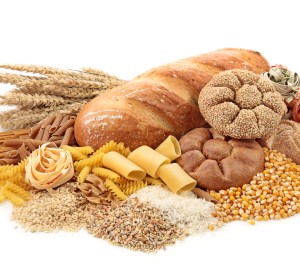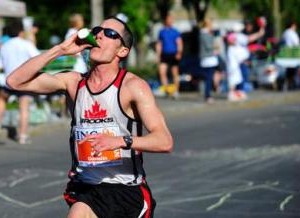
Monumental runners, get ready! The Indianapolis Monumental Marathon and Half Marathon are in SIX DAYS. Wow. Months of training, fueling and committing yourself to a challenge. However, the few days leading up to a race are crucial to your performance. We know to get plenty of rest, but what about our intake? We have all heard the term “carb loading,” but how much (or little) should we eat in these next few days leading up to the big day? No worries, Brooke P. here to help with an overview on what exactly carb loading is and how to do it right!
Monumental Fuel: The importance of nutrition in running performance
As the weather gets colder, some of you may be planning to run the Indianapolis
Monumental Marathon in a few weeks. Others may have your sights on running the “Mini” in May. No matter the distance, knowing how to fuel your body during training and on race day is of monumental (pun intended!) importance if you hope to achieve your goals.
It’s no surprise that proper nutrition is key in fueling distance runners and athletes overall. Not only does training for a marathon require plenty of carbohydrates and fluid, but also healthy fats, lean proteins and antioxidants from fruits and vegetables. In truth, fueling an endurance activity isn’t all that much different from how we all should be fueling ourselves on a regular basis–it just elevates it to a higher level.
So why is good nutrition important? As dietitians, we are taught that whole (unrefined or minimally processed) foods are the ideal way to get the nutrients needed to fuel a body properly. Whether you are a recreational runner or an elite athlete, the nutrients and antioxidants in whole foods help:
- Provide energy to fuel muscles
- Prevent oxidative stress and cell damage
- Maintain immune function
- Prevent injuries by reducing inflammation
Carbohydrates are the primary source of energy needed for muscle function during exercise. They also help your body spare protein and maintain lean muscle mass. Running, in particular, takes a steady stream of carbohydrates to keep muscles moving. Your body can store as much as 2,000 calories worth of carbohydrate as glycogen in liver and muscle cells. While this sounds like a lot, consuming insufficient carbohydrates before and during a marathon run, will cause you to “hit a wall” as your body’s stores run out. This makes consuming carbohydrates in the days before the race (carbloading) as important as fueling along the route. Not only do these sports drinks and foods provide you with additional carbohydrates, but they also help replenish lost sodium and electrolytes.
According to the International Olympic Committee (IOC), “As events increase in duration, athletes are encouraged to consume up to 90g/hour (of carbohydrate) from a variety of sports foods and drinks.” Practically, a good goal is to consume about 0.5g of carbohydrates per pound of body weight per hour. For a 150 pound person, this is about 75 grams of carbohydrate per hour of endurance exercise. Eating a high carbohydrate meal like pasta or a stir-fry with rice the night before a race helps maximize glycogen stores in the muscles and liver, so that these sources of fuel are used first. This is also one time when it is not recommended to eat a high fiber meal or to try something new, less you risk unwanted gastrointestinal distress. Stick with what you know you can tolerate on race day!
Oxidative stress, as defined by Merriam-Webster, is “physiological stress on the body that is caused by the cumulative damage done by free radicals inadequately neutralized by antioxidants…” It sounds complicated, but imagine exercise is like a battery-operated bubble blower. Once you add bubble juice and turn it on, it generates a stream of bubbles that are free to float around as they please. In the case of free radicals, exercise generates them in your body, and they are free to float around, potentially damaging the DNA in cells. If you immediately pop the bubbles, they dissipate and can’t float around anymore. Similarly, antioxidants can stop free radicals in their tracks. Found in high amounts in foods like fruits and vegetables, these potent molecules help stop the free radicals generated by exercise, stress and even normal aging, so they can no longer damage cells. This makes eating a wide variety of colorful foods like fruits and vegetables, along with whole grains, nuts and beans all the more important during training and post-race refueling.
Failing to eat soon after a long run or other intense exercise may also suppress immune function. This is because the body is trying to recover, and without proper fuel, it has to prioritize! Over time, improper or insufficient fueling can lead to increased likelihood of colds and other illness. The rate at which carbohydrates should be replaced depends on the time and intensity of training. For hard training (multiple sessions in one day, or high volume, high intensity training), replenishing carbohydrates immediately after training is essential. Aim to consume 0.5g of carbohydrate per pound of your body weight, followed by a meal an hour later. For moderate training lasting at least an hour, it’s a good idea to have a snack containing carbohydrate (30-60g) within 30-60 minutes of finishing a workout, followed by a meal within 2 hours. Adding 15-20g of protein also helps support muscle mass. If you are exercising less than an hour, eating a meal or snack within a few hours of a workout is sufficient. Snacks can be anything from a banana with peanut butter to chocolate milk to a turkey sandwich with fruit or veggies, depending on your calorie needs and fitness goals.
Reducing inflammation to help prevent training and race-day injuries is where healthy fats play a key role. Foods that are good sources of Omega-3 fatty acids are especially important. These fats are found in fatty fish like salmon, tuna and trout, as well as walnuts, canola oil, flax and chia seeds (Yes, the kind you make chia pets with!) Along with its role in calcium absorption and bone health, fat soluble Vitamin D is also important for muscle recovery. While it can be found in fortified dairy products, fatty fish and egg yolks, it is also easily made through moderate sun exposure (about 10 minutes) during the spring and summer months. This is one vitamin that may warrant supplementation during the winter months, especially in more northern states, like Indiana.
Lastly, staying hydrated is important not only for better athletic performance, but also for faster recovery. Fluid needs vary widely among individuals, and a loss of little as 2% of your body weight can affect performance. Genetics, body composition, fitness level, environment, altitude, and type and intensity of training can all play a role. Water is recommended, but sports drinks may also be necessary to replenish electrolytes and carbohydrate stores, especially in extreme weather, at high altitudes or with intense exercise lasting more than 60 minutes (like a marathon). A simple way to gauge hydration status is to examine the color of your urine. If you are well hydrated, it should be clear to pale yellow. Be aware that over-hydration, like dehydration, also carries serious health risks. If you experience stomach discomfort or find you are gaining weight from fluid intake, it is time to stop.
So, whether you plan to hit the pavement on November 1st, or you just want to enjoy running in the cooler days of fall, staying hydrated and fueling your body with healthy foods is the key to getting the most out of your mileage while keeping your body in shape from the inside out.
References:
- Position of the American Dietetic Association, Dietitians of Canada, and the American College of Sports Medicine: Nutrition and Athletic Performance. Journal of the American Dietetic Association, 2009; 109:509-527.
- Rosenbloom, C. and Coleman, E. Sports Nutrition, A Practice Manual for Professionals, 5th ed. Academy of Nutrition and Dietetics; 2012.
- Website: http://www.teamusa.org/About-the-USOC/Athlete-Development/SportPerformance/Nutrition, accessed April 21, 2014.
- International Olympic Committee (IOC). Sports Nutrition Consensus Statement, 2010. Retrieved from http://www.olympic.org/Documents/Reports/EN/CONSENSUS-FINALv8-en.pdf, October 2014.
- Merriam-Webster Dictionary. Retrieved from http://www.merriam-webster.com/ medical/oxidative%20stress, October 2013.
Thank you very much Brooke! Such a useful post to all distance runners and other endurance athletes! Thank you and good luck to everyone running this Saturday! See you at the finish line 🙂




